Floor Spring Door Closers
Rod Fathers
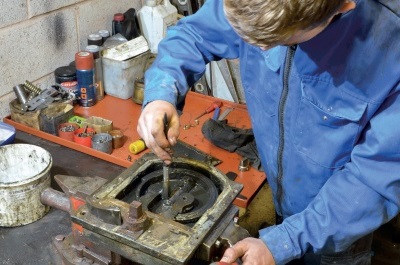 |
|
| Connor Haywood of Midlands Floor Springs repairing a Leader floor spring with concentric horseshoe-shaped springs, two of which are broken. The small device in the middle is a limiter which slows the speed of the closing door by forcing oil through a small hole in the cylinder or ‘dashpot’. |
Door closers perform a number of useful functions and will serve faithfully for many years if properly maintained. They save energy by minimising heat loss, prevent accidents by ensuring that heavy doors don’t slam shut suddenly, aid security by ensuring that doors latch automatically and prevent the spread of fire by keeping internal doors closed.
Traditional floor springs and door closers have become victims of their own success. They are such simple, effective and reliable devices that we only tend to notice them if they fail.
Efforts to repair and maintain them almost invariably result in modern suppliers explaining that the only option is to fit a new one. As a result, historic door closers are frequently replaced with characterless, often inferior, modern products. Yet they are part of the character and significance of the interior. Many are over 100 years old and of historic significance in their own right.
MAIN TYPES
There are three main types of door closer: surface-mounted (the most common), overhead or transom door closers (concealed in the header or transom of the door frame), and the most reliable and long lasting of all, the floor-mounted door spring (known in the trade as a floor spring).
Surface-mounted door springs such as the Briton, which is still common in old buildings, are designed for doors that only open one way and are known as single-action door closers. Transom closers and floor springs are manufactured for doors that can open either inward or outward and are often collectively referred to as double-action door closers. There are also single-action variants of both the transom closer and the floor spring which are found mainly on entrance doors.
HISTORY
Door closers were probably invented soon after door hinges. It is easy to imagine a series of pulleys, a weight and a length of twine used in combination to automate the closing of a door.
One of the earliest documented inventions for a door opening and closing device was invented by Heron of Alexandria (c10-70 AD). This ingenious mechanism used heat, pneumatics and pulleys to automate the opening of temple doors.
|
||||||||||||||||||||||||||||||||||||||||||||||||||
In the UK, all manner of varieties of door closer have been found dating from the 17th and 18th centuries, but all those produced since the advent of the Industrial Revolution have used some sort of spring device to store the energy produced when the door is opened so that it closes again. For a floor spring, this was achieved by supporting the bottom corner of the door in a metal shoe with a socket which locates on to a pin projecting from the device set in the floor. The bottom of this pin attaches to some form of spring mechanism concealed below a brass plate.
Early door closing devices were clearly influenced by the clock-making industry because many designs incorporated a heavy-duty clock type spring at their heart. Designs had become simpler and more effective by the end of the Georgian period. However, it was not until the late 19th and early 20th centuries that door closers as we know them were reliable enough to become standard fittings on high traffic doors throughout the world.
It is documented that a Mr Smith invented an early door closing device in 1770 at his premises at 69 Princes Street, London, laying the foundations for one of the most successful companies in the following century, Archibald Smith and Stevens. In the early 19th century a succession of developments are recorded and patented (see table). The transactions of the Society Instituted at London for the Encouragement of Arts, Manufactures and Commerce records that a Silver Medal and five guineas were awarded to a Mr James Stone for his door spring invention of 1814. White’s double door spring was invented in 1822, and Edwin Showell & Sons was producing floor springs from 1830.
Mid-19th century improvements by FW Gerish and JM Aldridge to the design of hinges resulted in many manufacturers abandoning traditional door hinges in favour of a top pivot. Very often these were adjustable, many retracting into the header with the turn of a slotted screw.
Early floor springs had no check devices, and relied on friction to slow the speed of the closing door. However, following the introduction of pivots and improvements in the bearings, some sort of mechanism was needed to ‘check’ the speed of the door. Early devices used a pneumatic piston, much like a bicycle pump, although some may have used a second set of springs to counter the force stored in the first.
As well as conventional cylindrical springs, some early 19th-century examples continued to use flat clock-type coil springs, and there are a few examples which used leaf springs.
Apart from the addition of the pneumatic check, floor springs made in the 19th century tend to be simpler than the early examples, with fewer moving parts. Cylindrical springs predominated, mostly working in tension, but compression springs are not uncommon.
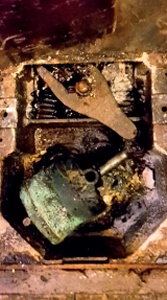 |
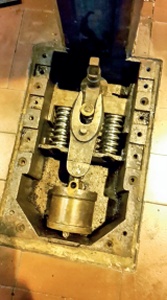 |
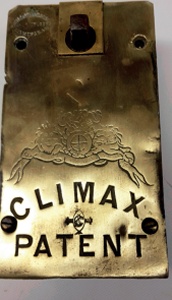 |
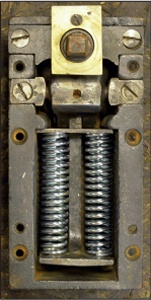 |
| An Invincible with a pneumatic limiter, before and after repair. Originally developed by James Cartland & Sons, the Invincible was later made under patent by WH Newman. | James Cartland & Sons’ Climax floor spring, first produced in the 1830s, with two springs but no limiter. | ||
By the late 19th century the hydraulic piston or ‘dashpot’ had emerged as the most common type of check device. It uses viscous friction to dampen the force released from the springs in the floor closers. Mechanisms for controlling the strength of the springs, which had first appeared in the mid 19th century were refined, allowing greater control over the closing speed.
By the end of the Victorian era the door closer business was booming and it continued to flourish through the Edwardian period. In an advert from the 1906 edition of The Contractors’, Merchants’ and Estate Managers’ Compendium and Catalogue, Colledge and Bridgen of Wolverhampton was claiming that over 20,000 of its Perfect floor springs ‘…were in daily use in many of the largest and most important buildings in the United Kingdom and abroad’.
CONSERVATION
Located below the floor, floor springs are vulnerable to dust, dirt and water from floor washing. If poorly maintained, corrosion products and dirt accelerate wear. Metal fatigue in the springs also causes them to fail, and ill-considered interventions add to the problems.
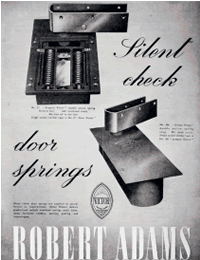 |
|
| The Victor range of Silent Check door springs from a 1950s advertisement: perhaps the Rolls Royce of floor springs was the London Victor, patented by Robert Adams in 1891. |
Carpet fitters and flooring contractors often place washers on top of the pivot to lift the shoe and hence the door as a ‘quick-fix’ to accommodate the new height of the flooring material they have laid. In the long run, however, this can cause major damage to the floor-spring pin/shoe combination and is one of the hardest faults to overcome when servicing and repairing floor springs.
Because most pins are tapered, lifting the shoe with washers also lifts the shoe off the tapered pin and allows the shoe to move about on it. This will either cause wear to the pins (even though they are hardened) or, worse, to the square or oblong hole in the shoe into which the pin fits. It is very difficult and time-consuming to fill, drill and then file the hole square again, especially because of the taper. There are ways to raise the shoe and therefore the door from inside the floor spring; washers are not the way to do it.
It is true that the traditional floor spring has now been made obsolete by cheap modern sealed units which are ‘maintenance free’ (in that they have a relatively short service life and cannot be repaired). It is not true, however, that there is nothing that can be done to a traditional door closer, especially a floor spring, other than to fit a modern one.
Although parts are no longer available from companies like WH Newman, several specialist companies in the UK are now manufacturing the components required for the conservation and repair of floor springs. A specialist engineer should be able to service or repair any historic door closer, allowing these pieces of Georgian, Victorian or Edwardian ingenuity and engineering to continue faithfully performing their function for many decades to come.



